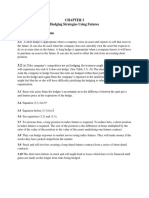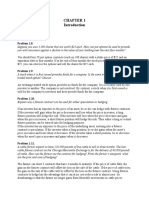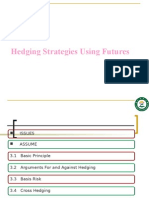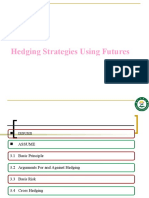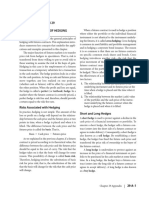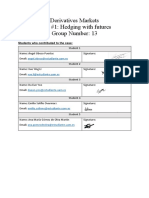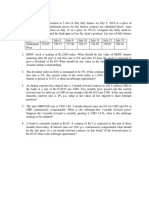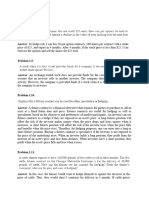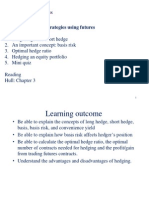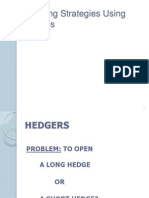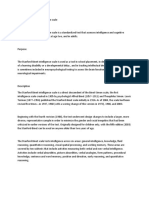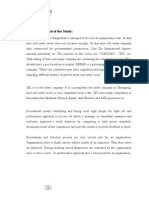SUGGESTED ANSWERS
CHAPTER 3: Hedging Strategies Using Futures
Practice Questions
1. Problem 3.8.
In the Chicago Board of Trade’s corn futures contract, the following delivery months
are available: March, May, July, September, and December. State the contract that
should be used for hedging when the expiration of the hedge is in
a) June
b) July
c) January
A good rule of thumb is to choose a futures contract that has a delivery month as close
as possible to, but later than, the month containing the expiration of the hedge. The
contracts that should be used are therefore
(a) July
(b) September
(c) March
2. Problem 3.9.
Does a perfect hedge always succeed in locking in the current spot price of an asset
for a future transaction? Explain your answer.
No. Consider, for example, the use of a forward contract to hedge a known cash
inflow in a foreign currency. The forward contract locks in the forward exchange rate
— which is in general different from the spot exchange rate.
3. Problem 3.10.
Explain why a short hedger’s position improves when the basis strengthens
unexpectedly and worsens when the basis weakens unexpectedly.
The basis is the amount by which the spot price exceeds the futures price. A short
hedger is long the asset and short futures contracts. The value of his or her position
therefore improves as the basis increases. Similarly it worsens as the basis decreases.
4. Problem 3.13.
“If the minimum-variance hedge ratio is calculated as 1.0, the hedge must be perfect."
Is this statement true? Explain your answer.
The statement is not true. The minimum variance hedge ratio is
S
F
It is 1.0 when 05 and S 2 F . Since 10 the hedge is clearly not perfect.
1
� 5. Problem 3.14.
“If there is no basis risk, the minimum variance hedge ratio is always 1.0." Is this
statement true? Explain your answer.
The statement is true. Using the notation in the text, if the hedge ratio is 1.0, the
hedger locks in a price of F1 b2 . Since both F1 and b2 are known this has a variance
of zero and must be the best hedge.
6. Problem 3.16.
The standard deviation of monthly changes in the spot price of live cattle is (in cents
per pound) 1.2. The standard deviation of monthly changes in the futures price of live
cattle for the closest contract is 1.4. The correlation between the futures price changes
and the spot price changes is 0.7. It is now October 15. A beef producer is committed
to purchasing 200,000 pounds of live cattle on November 15. The producer wants to
use the December live-cattle futures contracts to hedge its risk. Each contract is for
the delivery of 40,000 pounds of cattle. What strategy should the beef producer
follow?
The optimal hedge ratio is
12
07 06
14
The beef producer requires a long position in 200000 06 120 000 lbs of cattle. The
beef producer should therefore take a long position in 3 December contracts closing
out the position on November 15.
7. Problem 3.17.
A corn farmer argues “I do not use futures contracts for hedging. My real risk is not
the price of corn. It is that my whole crop gets wiped out by the weather.”Discuss this
viewpoint. Should the farmer estimate his or her expected production of corn and
hedge to try to lock in a price for expected production?
If weather creates a significant uncertainty about the volume of corn that will be
harvested, the farmer should not enter into short forward contracts to hedge the price
risk on his or her expected production. The reason is as follows. Suppose that the
weather is bad and the farmer’s production is lower than expected. Other farmers are
likely to have been affected similarly. Corn production overall will be low and as a
consequence the price of corn will be relatively high. The farmer’s problems arising
from the bad harvest will be made worse by losses on the short futures position. This
problem emphasizes the importance of looking at the big picture when hedging. The
farmer is correct to question whether hedging price risk while ignoring other risks is a
good strategy.
8. Problem 3.18.
On July 1, an investor holds 50,000 shares of a certain stock. The market price is $30
per share. The investor is interested in hedging against movements in the market over
the next month and decides to use the September Mini S&P 500 futures contract. The
2
�index is currently 1,500 and one contract is for delivery of $50 times the index. The
beta of the stock is 1.3. What strategy should the investor follow? Under what
circumstances will it be profitable?
A short position in
50 000 30
13 26
50 1 500
contracts is required. It will be profitable if the stock outperforms the market in the
sense that its return is greater than that predicted by the capital asset pricing model.
9. Problem 3.21.
The expected return on the S&P 500 is 12% and the risk-free rate is 5%. What is the
expected return on the investment with a beta of (a) 0.2, (b) 0.5, and (c) 1.4?
a) 005 02 (012 005) 0064 or 6.4%
b) 005 05 (012 005) 0085 or 8.5%
c) 005 14 (012 005) 0148 or 14.8%
10. Problem 3.24.
It is July 16. A company has a portfolio of stocks worth $100 million. The beta of the
portfolio is 1.2. The company would like to use the CME December futures contract
on the S&P 500 to change the beta of the portfolio to 0.5 during the period July 16 to
November 16. The index is currently 1,000, and each contract is on $250 times the
index.
a) What position should the company take?
b) Suppose that the company changes its mind and decides to increase the beta of
the portfolio from 1.2 to 1.5. What position in futures contracts should it take?
a) The company should short
(12 05) 100 000 000
1000 250
or 280 contracts.
b) The company should take a long position in
(15 12) 100 000 000
1000 250
or 120 contracts.










